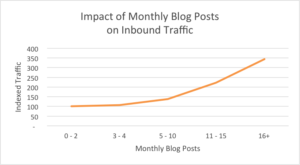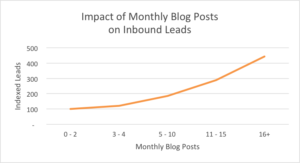I am sure you are done reading all that you had to read on how to grow your business by now. All that reading isn’t going to help if you don’t do anything about it.
It’s time to wear your socks, grab your gear, and take some kickass action.
I am going to do it and I believe you’ll want to do it too. For the last 6 months or so, there have been thousands of thoughts in my head about what exactly I need to do to make my business work. If you are anything like me, I am sure you’d be thinking on those lines too.
Here’s what I planned to grow my business and I am sure these will do you good.
Blog Regularly
I am guilty of not blogging regularly. For all the marketing and personal branding; for all the productivity tips and getting better at the trade; I just didn’t have enough mojo to pull myself to blog for fetchprofits.com.
That’s changing as I write this. I decided to write for myself while writing for clients. I can’t be talking about how important blogs are and consult clients while my blog doesn’t have much for me to write home about.
The more you blog, the better the better your chances are of generating leads. In the last 3-4 months that I’ve been blogging regularly here, I already got 3 new clients with a total order value of $2800 per month.
What about traffic you ask?
Just by blogging regularly (3 times per week), I already see a 505% increase since last year.
Yes, that’s how powerful it is.
According to Lindsay Kolowich of Hubspot, the new benchmarking data on blogging frequency shows this:
“Companies that published 16+ blog posts per month got almost 3.5X more traffic than companies that published between 0 – 4 monthly posts”

Companies that blog frequently also open up more opportunities in terms of leads.
“Companies that published 16+ blog posts per month got about 4.5X more leads than companies that published between 0 – 4 monthly posts.”

I am making this one single change that’ll stick. How about you?
Create landing pages. For every campaign
My head’s always conjuring up landing pages for every single offer I think of — for my business and for each of my clients. I’ve actually begun to visualize how landing pages “should” look like for every blog post, tweet, updates on other social media networks, and even paid ads.
So, if an ad says, “Get clients. Pitch effectively”, I am already beginning to wonder how the landing page should look like. Well, that’s me.
It’s easy enough to create landing pages that work with With tools such as Unbounce, Leadpages, and Instapage
Here are a few examples of landing pages you should be building:


Remember: you’ll need separate landing pages for every campaign. Create them and send traffic.
Begin testing everything
- Are your CTA buttons working?
- Do you subscribers open your emails? If so, do they read? While they read, do they click?
- Are any of the clicks spilling over to your precious CTA button within the email?
- Are your landing pages working the way they should?
- How are your blog posts performing? How is your website performing overall?
The stupid way is to go ahead with all those campaigns while precious marketing dollars.
The smart way is to test. For landing pages, Leadpages and Unbounce both have A/B testing as a part of their offering.
For everything else, there’s Optimizely.
Test your design elements, landing pages, blog posts, home page, Calls to action, offers, copy, and even placement of social media buttons.
Take lessons. Enhance your skills
We all need dynamic feeding of skills into us. If nothing is constant, then we need to change what we know and what we can do. I am not just content with writing posts and then writing some more posts for clients.
I want to do a lot more. So, I made the deep dive. I am currently crawling through the entire suite of Adobe Products to learn design. I hacked my way to learn coding, and I am also adding many other services to my portfolio.
Note: all my learning is work in progress. I don’t know when I’d get proficient at these things but I will.
What’s new thing you’d like to learn?
Push Yourself
Here’s another thing I was wrong with: I live with the smug satisfaction (perceived) that I am doing well enough. When I look around (another guilt), I know that there’s a long way to go for me. I could do better.
I can bring in the rain. I can tear houses down. I can go and whistle on the streets. All I need to do is to push myself to do more. Break my own records, every day.
So, don’t just blog, get active on social, send out emails with cold outreach, and launch campaigns. Try other things you never did. Like Cold email outreach, get on the phone call with an old customer, speak events, attend conferences, or whatever you haven’t done yet.
That applies to writing, marketing, productivity, management, and lots of other things.
Inbound Marketing is the key
Look at any business that rocks it up and you’ll see a pattern. HubSpot never stops producing more relevant content. Unbounce, Kissmetrics, Moz, and many others just don’t stop with content creation, ever.
No matter how you look at it, producing content relentlessly is much cheaper and more effective than spending on any other kind of marketing you’d want to.
According to data from WebDAM Solutions, Inbound marketing delivers a whopping 54% more leads than traditional outbound marketing can.
It’s not about “this or that”; it’s “everything that works”
For modern day marketing, every choice you make is measurable. There is a broad spectrum of channels available for digital marketing, but you cannot choose one against the other. It doesn’t make sense “not” to spend all your time on Twitter when your business brings up more than 1745 mentions on Twitter per day, can you?
Really then, it’s not about choosing one platform over the other. It’s not even sticking to your favourites — no one (especially your customers) won’t care if you like Twitter more than Facebook.
Marketing 101: you go where your customers are
Instead of wasting time with choices, strategically pick your platforms depending on what works for you. If you’ve noticed plenty of traffic coming from Facebook but most conversations and engagement happen on Twitter, you’ll be on both of those platforms. If you were in B2B, you’d be on LinkedIn even if the engagement weren’t anything like it is elsewhere.
I wrote more about lead generation in this short guide.
It also makes sense to look out for more social platforms such as Google+, Instagram, and others.
Similarly, a few content types might work better for you than others. A few marketing channels seem to be giving you more sales and marketing mojo.
Your work is to find out what works and hang on to it.
Keep those old customers, no matter what
It’s easier to keep old customers than to gain new ones. In fact, according to an infographic from Flowtown – thanks to the folks at Spoken.com for sharing it – it’s at least 6-7 times more expensive to acquire a customer than it is to retain an existing one.
Just by boosting customer retention rate as much as 5%, increased profits translate to anywhere from 5 – 95%. Further, existing customers are more likely to buy from you while being less sensitive to price increases.
So keep those old customers engaged using Email Marketing (make sure you have their permission first). Connect with them on social media. Support them (even if they aren’t doing business with you anymore).
Do what you have to. That reminds me: what exactly are you going to do for marketing your business?
The question is: what you are going to do differently? Tell me all about it.
